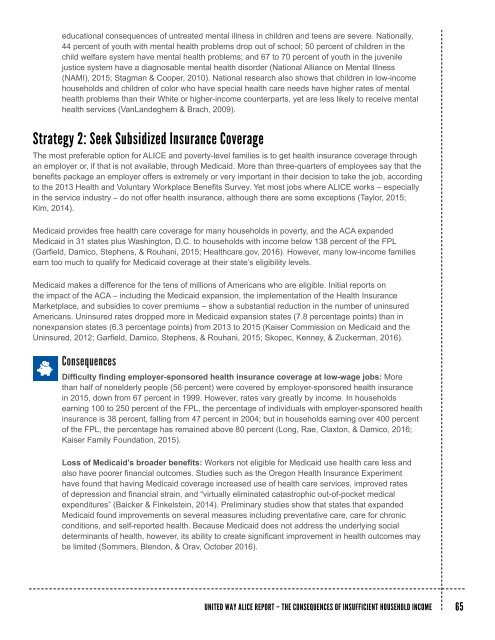The Consequences of Insufficient Household Income
This new Consequences of Insufficient Household Income report provides a deeper level of understanding of the choices that ALICE and poverty-level families across the country make when they do not have enough income or assistance to afford basic necessities, and the consequences of those choices.
This new Consequences of Insufficient Household Income report provides a deeper level of understanding of the choices that ALICE and poverty-level families across the country make when they do not have enough income or assistance to afford basic necessities, and the consequences of those choices.
Create successful ePaper yourself
Turn your PDF publications into a flip-book with our unique Google optimized e-Paper software.
educational consequences <strong>of</strong> untreated mental illness in children and teens are severe. Nationally,<br />
44 percent <strong>of</strong> youth with mental health problems drop out <strong>of</strong> school; 50 percent <strong>of</strong> children in the<br />
child welfare system have mental health problems; and 67 to 70 percent <strong>of</strong> youth in the juvenile<br />
justice system have a diagnosable mental health disorder (National Alliance on Mental Illness<br />
(NAMI), 2015; Stagman & Cooper, 2010). National research also shows that children in low-income<br />
households and children <strong>of</strong> color who have special health care needs have higher rates <strong>of</strong> mental<br />
health problems than their White or higher-income counterparts, yet are less likely to receive mental<br />
health services (VanLandeghem & Brach, 2009).<br />
Strategy 2: Seek Subsidized Insurance Coverage<br />
<strong>The</strong> most preferable option for ALICE and poverty-level families is to get health insurance coverage through<br />
an employer or, if that is not available, through Medicaid. More than three-quarters <strong>of</strong> employees say that the<br />
benefits package an employer <strong>of</strong>fers is extremely or very important in their decision to take the job, according<br />
to the 2013 Health and Voluntary Workplace Benefits Survey. Yet most jobs where ALICE works – especially<br />
in the service industry – do not <strong>of</strong>fer health insurance, although there are some exceptions (Taylor, 2015;<br />
Kim, 2014).<br />
Medicaid provides free health care coverage for many households in poverty, and the ACA expanded<br />
Medicaid in 31 states plus Washington, D.C. to households with income below 138 percent <strong>of</strong> the FPL<br />
(Garfield, Damico, Stephens, & Rouhani, 2015; Healthcare.gov, 2016). However, many low-income families<br />
earn too much to qualify for Medicaid coverage at their state’s eligibility levels.<br />
Medicaid makes a difference for the tens <strong>of</strong> millions <strong>of</strong> Americans who are eligible. Initial reports on<br />
the impact <strong>of</strong> the ACA – including the Medicaid expansion, the implementation <strong>of</strong> the Health Insurance<br />
Marketplace, and subsidies to cover premiums – show a substantial reduction in the number <strong>of</strong> uninsured<br />
Americans. Uninsured rates dropped more in Medicaid expansion states (7.8 percentage points) than in<br />
nonexpansion states (6.3 percentage points) from 2013 to 2015 (Kaiser Commission on Medicaid and the<br />
Uninsured, 2012; Garfield, Damico, Stephens, & Rouhani, 2015; Skopec, Kenney, & Zuckerman, 2016).<br />
<strong>Consequences</strong><br />
Difficulty finding employer-sponsored health insurance coverage at low-wage jobs: More<br />
than half <strong>of</strong> nonelderly people (56 percent) were covered by employer-sponsored health insurance<br />
in 2015, down from 67 percent in 1999. However, rates vary greatly by income. In households<br />
earning 100 to 250 percent <strong>of</strong> the FPL, the percentage <strong>of</strong> individuals with employer-sponsored health<br />
insurance is 38 percent, falling from 47 percent in 2004; but in households earning over 400 percent<br />
<strong>of</strong> the FPL, the percentage has remained above 80 percent (Long, Rae, Claxton, & Damico, 2016;<br />
Kaiser Family Foundation, 2015).<br />
Loss <strong>of</strong> Medicaid’s broader benefits: Workers not eligible for Medicaid use health care less and<br />
also have poorer financial outcomes. Studies such as the Oregon Health Insurance Experiment<br />
have found that having Medicaid coverage increased use <strong>of</strong> health care services, improved rates<br />
<strong>of</strong> depression and financial strain, and “virtually eliminated catastrophic out-<strong>of</strong>-pocket medical<br />
expenditures” (Baicker & Finkelstein, 2014). Preliminary studies show that states that expanded<br />
Medicaid found improvements on several measures including preventative care, care for chronic<br />
conditions, and self-reported health. Because Medicaid does not address the underlying social<br />
determinants <strong>of</strong> health, however, its ability to create significant improvement in health outcomes may<br />
be limited (Sommers, Blendon, & Orav, October 2016).<br />
UNITED WAY ALICE REPORT – THE CONSEQUENCES OF INSUFFICIENT HOUSEHOLD INCOME<br />
65




